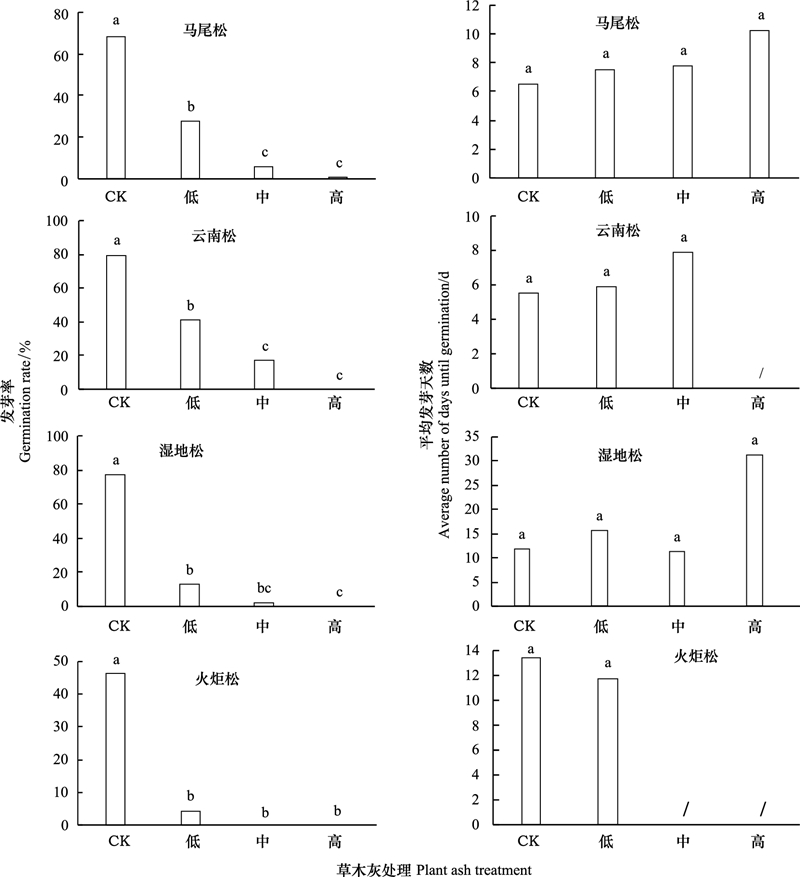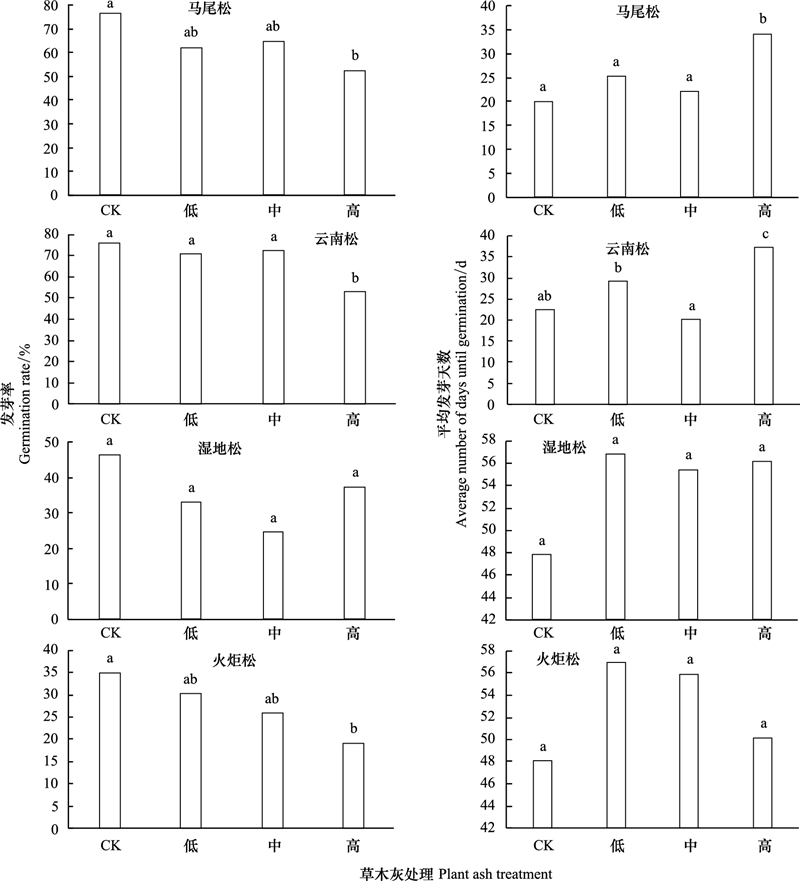文章信息
- 刘发林
- LIU Falin.
- 草木灰对四种松属种子发芽和幼苗生长的影响
- Response of four pine species to plant ash during germination and seedling growth
- 生态学报. 2017, 37(17): 5673-5680
- Acta Ecologica Sinica. 2017, 37(17): 5673-5680
- http://dx.doi.org/10.5846/stxb201605311043
-
文章历史
- 收稿日期: 2016-05-31
- 网络出版日期: 2017-04-24
森林火灾不仅影响生态系统的结构与功能, 而且影响群落更新[1]。火干扰后森林地表覆盖一层灰烬, 即植物(草本和木本植物)燃烧后的残余物, 俗称草木灰, 其质轻且呈弱碱性[2-3]。草木灰是一种良好的无机肥料, 具有消毒、增强植物抗逆性、促进植物发芽和生根及伤口愈合等作用。Raison[4]调查发现稀树草原、森林燃烧后留下的草木灰达100—12000 kg/hm2, Carreira和Niell[5]研究地中海灌木林火烧后草木灰约486 kg/hm2, Soto[6]等研究大西洋灌丛火烧后草木灰约87 kg/hm2。北半球松属植物生态系统经常遭受火灾[7], 有学者对广泛分布于北半球的欧洲黑松(Pinusnigra)、欧洲红松(Pinussylvestris)、海岸松(Pinuspinaster)的更新进行了研究, 大多数松属植物不能萌芽更新, 主要通过种子更新[8-12], Agee研究了英国部分松属植物种子萌发和生长对火干扰的响应[13];国内有学者就水分胁迫、NaCl胁迫、钙浸种和不同基质对马尾松(Pinusmassoniana)或华山松(Pinusarmandii)种子发芽及生长的影响进行过研究[14-17], 但关于草木灰对火炬松(Pinustaeda)、湿地松(Pinuselliottii)、云南松(Pinusyunnanensis)等松属种子萌芽和幼苗生长的研究未见报道。为了比较草木灰对马尾松、云南松、湿地松、火炬松种子萌发及幼苗生长的影响, 在湖南省株洲市黄丰桥林场采集种子, 收集该场马尾松次生林火烧迹地草木灰作为基质, 设置1个对照与3个不同草木灰含量处理, 观测4个物种种子萌发及幼苗生长, 为火干扰后火烧迹地天然更新或人工促进天然更新提供参考。
1 材料与方法 1.1 试验区概况黄丰桥林场呈带状横跨于湖南省攸县东西部, 以中低山貌为主, 海拔介于1270—115 m, 坡度在20°—35°之间。主要成土母岩为板页岩, 土壤以板页岩发育而成的山地黄壤为主, 土壤肥沃。林场属亚热带季风湿润气候区, 年平均气温为17.8℃, 年降水量为1410.8 mm, 无霜期292 d。境内森林茂盛, 物种丰富, 据考察有木本植物430余种, 其中国家保护的珍稀濒危树种有南方红豆杉(Taxusmairei)、银杏(Ginkgo biloba)、凤凰树(Delonixregia)等10余种, 主要林分类型为杉木(Cunninghamialanceolata)、马尾松、湿地松、火炬松和云南松等人工林, 其次有马尾松次生林、针阔(如马尾松-檵木(Loropetalumchinensis)针阔混交林)和阔叶混交林, 林场培养了主要树种的母树林。受南方冰雪灾害的影响, 2008年以来林场发生森林火灾(含火警)14次, 受害面积共8.4hm2。
1.2 试验设计2013年12月中旬在黄丰桥林场马尾松、湿地松、火炬松和云南松母树林采集成熟种子, 将干燥种子用塑料袋密封。种子纯度为95%时, 马尾松、湿地松、火炬松和云南松种子千粒重分别为10.95、29.45、20.12 g和16.99 g, 0—5℃低温下贮藏。2015年3月10日进行播种前处理, 采用水洗法选出饱满籽粒, 用45℃温水浸种24 h, 滤干后用0.15%的福尔马林溶液消毒30 min, 再用蒸馏水冲洗3次, 备播种试验。试验均在实验室条件下进行, 并测定不同草木灰使用量处理的发芽率。基质为马尾松次生林地表火后的草木灰, 火烧后收集地表草木灰并充分混合。
试验1:在直径9 cm双层滤纸上进行试验, 滤纸置于培养皿上, 以不用草木灰试验为对照(CK), 3种不同草木灰含量的试验处理为:Low(低4 kg/hm2)、Medium(中8 kg/hm2)和High(高:16 kg/hm2), 按试验处理量将草木灰均匀的铺在滤纸上, 植物种子放置在草木灰上, 每个处理播种30粒, 重复3次。用10 mL蒸馏水滴于培养皿, 培养期间根据需要喷洒蒸馏水以保持种子湿润。2015年3月13日开始播种, 以45 d为1周期, 每两天观测发芽数(以胚根超出皮外1 mm以上为准)[18], 45 d后每周观测1次。根据观测数据计算发芽率、平均发芽时间和发芽时间分布, 平均发芽时间计算公式:

|
式中, N1为时间T1的发芽数, N2为时间T1与T2之间的发芽数, 依次类推[18]。
试验2:试验置于20 cm×20 cm×20 cm花盆, 草木灰铺放在花盆内土壤(黄心土48%、菌根土20%、火烧土30%、过磷酸钙2%)表面, 花盆底部铺一层珍珠岩避免种子霉变。草木灰试验处理、播种时间、重复次数和观测方法等与试验1相同;此外, 试验2中每周观测幼苗高1次, 直到播种后第14周, 根据存活苗数计算死亡率, 而后幼苗被连根拔起, 去泥土后放置于60℃干燥箱直至恒重, 测量幼苗的根、茎和叶的重量与长度。
1.3 统计分析观测数据输入Excel存储, 通过平方根的反余弦对发芽率观测数据进行转换, 通过以常用对数对幼苗高度数据进行对数转换, 采用SAS软件进行统计分析[19], 以物种和处理为独立变量, 对各试验数据进行多元方差分析。因此, 对物种之间及物种与处理之间相互作用进行差异性分析, 对培养皿及花盆中的发芽率、发芽时间、死亡率、各物种的幼苗高度、幼苗总重量及各器官的重量进行单变量方差分析, 当试验处理之间存在显著差异, 再进行LSD检验。
2 结果与分析 2.1 种子发芽率试验1, 培养皿播种4个物种种子发芽率随草木灰含量增加而减少(图 1), 低草木灰含量处理马尾松发芽率不及对照一半, 中、高草木灰含量处理发芽率更低;云南松种子发芽率规律类似于马尾松, 而高草木灰含量处理发芽率为0;湿地松种子对草木灰更敏感, 低、中、高草木灰含量处理下发芽率分别为13%、2%和0;火炬松种子低草木灰含量处理发芽率仅4%, 而中、高草木灰含量处理发芽率均为0。方差分析结果表明, 物种(P<0.05) 之间和处理(P<0.05) 之间均存在显著差异, 物种与处理之间的相互作用非常显著(P<0.01), 表明种子发芽率对草木灰处理的响应取决于物种。

|
| 图 1 培养皿播种后4种松属物种种子发芽率和平均发芽天数 Fig. 1 Germination rate and average number of days until germination for four Pinus species sown in Petri dishes |
试验2, 花盆播种4个物种种子发芽率在19.13%—76.14%之间变动(图 2)。除湿地松对照试验播种比培养皿播种种子发芽率低外, 草木灰处理下种子发芽率呈现随草木灰含量增加而降低的趋势。方差分析表明, 物种之间和草木灰处理之间种子发芽率存在极显著差异(P<0.01), 物种与处理之间差异显著(P<0.01);单变量方差分析表明各物种种子发芽率差异较小。高草木灰含量处理云南松种子发芽率最高, 与其他处理之间存在显著差异(P<0.05)。马尾松和火炬松种子发芽率在高草木灰处理与对照试验之间存在显著差异, 但高、中、低草木灰含量处理之间差异不显著。

|
| 图 2 花盆播种后4种松属物种种子发芽率和平均发芽天数 Fig. 2 Germination rate and average number of days until germination for four Pinus species sown in plant pots |
试验1, 4种松属物种种子的平均发芽时间不同, 马尾松和云南松种子比湿地松和火炬松种子发芽快(图 1), 经方差分析表明, 物种之间差异显著(P<0.01), 而草木灰处理之间差异不显著。
试验2, 花盆播种平均发芽时间比培养皿长(图 2)。马尾松和云南松种子平均发芽时间介于20—38 d, 而湿地松和火炬松介于48—57 d, 物种之间存在极显著差异(P<0.01), 草木灰处理之间存在显著差异(P<0.05), 物种与处理之间的交互作用不显著。处理之间湿地松和火炬松种子发芽时间没有显著差异, 而高草木灰处理与其他3种处理之间云南松种子发芽时间差异显著, 对照试验中马尾松种子发芽时间与其他3种草木灰处理之间存在差异。
2.3 幼苗死亡率4个物种种子播种14周后幼苗死亡率存在差异(图 3), 不同处理之间云南松幼苗死亡率介于27.06%—61.58%、马尾松幼苗死亡率介于14.35%—47.91%;而湿地松幼苗死亡率介于36.28%—65.81%、火炬松幼苗死亡率介于31.46%—62.15%。方差分析表明, 物种之间和处理之间均存在极显著差异(P<0.01), 但物种与处理之间的交互作用不显著。马尾松幼苗死亡率明显比其他3个物种低。低、高草木灰含量处理存在显著差异, 而中草木灰含量处理与对照和低草木灰含量处理相似。处理之间湿地松和火炬松幼苗死亡率不存在显著差异。

|
| 图 3 花盆播种后4种松属物种幼苗死亡率 Fig. 3 Seedling mortality rate of four Pinus species sown in plant pots |
播种14周后, 火炬松、湿地松、云南松和马尾松幼苗的单株平均干重分别达0.038、0.031、0.027、0.024 g(表 1), 湿地松和火炬松幼苗比马尾松和云南松重, 马尾松和云南松幼苗与湿地松和火炬松间的差异没有发芽率、平均发芽时间和死亡率显著。物种间存在显著差异(P=0.0024), 但试验处理间的差异不显著。
| 物种 Species |
器官 Organ |
项目 Project |
草木灰处理Plant ash treatment | |||
| CK | 低Low | 中Medium | 高High | |||
| 马尾松 Pinus massoniana |
叶 | 重量/g | 0.016 a | 0.015 a | 0.018 a | 0.014 a |
| 长度/cm | 1.82 a | 2.13 a | 1.99 a | 1.91 a | ||
| 茎 | 重量/g | 0.004 a | 0.005 a | 0.005 a | 0.004 a | |
| 长度/cm | 3.52 a | 3.60 a | 3.66 a | 3.58 a | ||
| 根 | 重量/g | 0.004 a | 0.005 a | 0.004 a | 0.003 b | |
| 长度/cm | 7.89 a | 6.45 a | 6.67 a | 6.11 a | ||
| 整株 | 重量/g | 0.024 a | 0.025 a | 0.027 a | 0.021 a | |
| 长度/cm | 13.23 a | 12.18 a | 12.32 a | 11.60 a | ||
| 云南松 Pinus yunnanensis |
叶 | 重量/g | 0.016 a | 0.016 a | 0.019 a | 0.016 a |
| 长度/cm | 1.65 a | 1.91 a | 2.01 a | 1.48 a | ||
| 茎 | 重量/g | 0.006 a | 0.006 a | 0.006 a | 0.005 a | |
| 长度/cm | 3.85 a | 4.20 a | 3.91 a | 3.84 a | ||
| 根 | 重量/g | 0.005 a | 0.006 a | 0.006 a | 0.005 a | |
| 长度/cm | 8.44 a | 7.85 a | 8.55 a | 7.21 a | ||
| 整株 | 重量/g | 0.027 a | 0.028 a | 0.031 a | 0.026 a | |
| 长度/cm | 13.94 a | 13.96 a | 14.47 a | 12.53 a | ||
| 湿地松 Pinus elliottii |
叶 | 重量/g | 0.019 a | 0.017 a | 0.020 a | 0.021 a |
| 长度/cm | 1.94 a | 1.91 a | 1.98 a | 2.23 a | ||
| 茎 | 重量/g | 0.005 a | 0.006 a | 0.006 a | 0.006 a | |
| 长度/cm | 4.02 a | 3.79 a | 3.55 a | 4.12 a | ||
| 根 | 重量/g | 0.007 a | 0.009 a | 0.006 a | 0.006 a | |
| 长度/cm | 11.64 a | 10.45 a | 8.21 a | 9.16 a | ||
| 整株 | 重量/g | 0.031 a | 0.032 a | 0.032 a | 0.033 a | |
| 长度/cm | 17.60 a | 16.15 a | 13.74 a | 15.51 a | ||
| 火炬松 Pinus taeda |
叶 | 重量/g | 0.024 a | 0.027 a | 0.026 a | 0.026 a |
| 长度/cm | 2.49 ab | 3.21 a | 1.95 a | 3.38 c | ||
| 茎 | 重量/g | 0.007 a | 0.007 a | 0.008 a | 0.007 a | |
| 长度/cm | 4.61 a | 3.72 a | 4.25 a | 4.36 a | ||
| 根 | 重量/g | 0.007 a | 0.007 a | 0.008 a | 0.009 a | |
| 长度/cm | 8.62 a | 8.21 a | 7.89 a | 8.01 a | ||
| 整株 | 重量/g | 0.038 a | 0.040 a | 0.041 a | 0.042 a | |
| 长度/cm | 15.72 a | 15.14 a | 14.09 a | 15.75 a | ||
4个物种树叶干重占幼苗总干重比例最大, 叶干重按降序排列依次为:火炬松(0.026 g)>湿地松(0.019 g)>云南松(0.017 g)>马尾松(0.016 g), 根和茎的干重相当, 约占对应物种幼苗叶干重的三分之一。多元方差分析表明物种和处理间不存在显著交互差异, 而物种之间存在极显著差异(P<0.01)。马尾松幼苗干重与其他3个物种有显著差异。分别对各物种进行分析发现, 茎和地上部分干重没有显著差异, 而根的干重差异显著。高草木灰含量处理马尾松幼苗根干重明显低于其他处理。
2.5 幼苗长播种14周后, 4个物种的幼苗长几乎没有差异(表 1), 平均长按降序依次为:湿地松(15.75 cm)>火炬松(15.25 cm)>云南松(13.72 cm)>马尾松(12.33 cm), 方差分析显示不同处理、不同物种整株幼苗长的差异不显著, 物种与处理之间的交互作用没有显著差异。平均根长度按降序排列分别为:湿地松(9.86 cm)>火炬松(8.18 cm)>云南松(8.01 cm)>马尾松(6.78 cm);茎长度按降序排列分别为:火炬松(4.23 cm)>云南松(3.95 cm)>湿地松(3.87 cm)>马尾松(3.59 cm);幼苗叶长度按降序排列分别为:火炬松(2.75 cm)>湿地松(2.01 cm)>马尾松(1.96 cm)>云南松(1.70 cm)。
对各物种幼苗各器官长度进行统计分析, 发现仅树叶长度在物种间差异显著(P<0.01)、物种与处理间的交互作用差异显著(P<0.014)。火炬松幼苗树叶比其他3个物种的长, 高草木灰含量试验处理下火炬松幼苗树叶比对照和中草木灰含量试验处理显著增长(P<0.05), 其他3个物种幼苗长度在草木灰试验处理间没有显著差异, 幼苗的根和茎长在物种间、试验处理间差异不显著, 在物种与试验处理间的交互作用也不显著。
3 结论与讨论以马尾松次生林火烧迹地草木灰进行试验, 对4种松属物种的种子发芽及幼苗生长进行观测, 发现火炬松和湿地松种子在高草木灰含量试验处理下发芽率最低, 除对照处理外, 花盆试验处理种子发芽率比培养皿中的高, 估计与花盆中土壤可以稀释草木灰和降低抑制发芽的碱性物质浓度有关, 因为低浓度碱性物质有利于植物种子发芽, 而高浓度碱性物质对种子发芽起抑制作用[20]。无论草木灰处理还是培养条件(培养皿或花盆), 马尾松和云南松种子平均发芽时间比湿地松和火炬松短。
对照试验中马尾松和云南松幼苗死亡率最低, 而火炬松和湿地松幼苗死亡率相对增加, 但增加不显著, 死亡率随草木灰含量的增加而明显上升, 表明火炬松和湿地松幼苗生长比马尾松和云南松对草木灰更敏感。
播种14周后4种松属物种幼苗的生长差异不明显, 因为4个物种的胚胎可以供给幼苗生长所需的营养, 幼苗的生长并不需要从草木灰或土壤中获取营养成分。有学者对其他物种进行试验研究, 发现2.5 a后高草木灰含量火烧迹地更新植物高是对照样地的2倍[21-22]。火炬松和湿地松在中、高草木灰含量试验中能生长良好, 说明有些物种能适应非酸性土壤, 这也正好说明了地中海松为何能在地中海碱性土壤下发芽和生长[23-24]。研究显示马尾松和云南松在草木灰处理试验中发芽率比湿地松和火炬松高, 这与湿地松和火炬松属国外引种松属有关, 因马尾松和云南松属本地物种, 更适合在研究区更新, 也是火烧迹地天然更新中的先锋树种之一。
曾经松树被认为是防火物种[25], 而如今学者认为松树不是防火树种[12, 26-27], 因为松属植物含有大量的松脂且松针属细小可燃物, 有利于林火的发生和蔓延。森林火灾高温对松属种子的发芽促进作用不明显[12, 28-29]。总体来看, 马尾松和云南松比湿地松和火炬松的适应性更强, 主要还是因为前者的种子体积小和重量轻, 便于种子传播。
研究结果发现, 低草木灰含量试验处理的4个松属种子的发芽率均比对照低, 因此今后对0—4 kg/hm2之间的浓度梯度进行试验, 筛选更适宜的草木灰浓度。
| [1] | 蔡文华, 杨健, 刘志华, 胡远满, 柳生吉, 荆国志, 赵增福. 黑龙江省大兴安岭林区火烧迹地森林更新及其影响因子. 生态学报, 2012, 32(11): 3303–3312. |
| [2] | 吕爱锋, 田汉勤, 刘永强. 火干扰与生态系统的碳循环. 生态学报, 2005, 25(10): 2734–2743. DOI:10.3321/j.issn:1000-0933.2005.10.040 |
| [3] | 韩春兰, 邵帅, 王秋兵, 李甄, 孙仲秀, 毛伟伟. 兴安落叶松林火干扰后土壤有机碳含量变化. 生态学报, 2015, 35(9): 3023–3033. |
| [4] | Raison R J. Modification of the soil environment by vegetation fires, with particular reference to nitrogen transformations:a review. Plant and Soil, 1979, 51(1): 73–108. DOI:10.1007/BF02205929 |
| [5] | Carreira J A, Niell F X. Mobilization of nutrients by fire in a semiarid gorse-scrubland ecosystem of Southern Spain. Arid Soil Research and Rehabilitation, 1995, 9(1): 73–89. DOI:10.1080/15324989509385875 |
| [6] | Soto B, Basanta R, Diaz-Fierros F. Effects of burning on nutrient balance in an area of gorse (Ulexeuropaeus L.) scrub. Science of the Total Environment, 1997, 24(3): 271–281. |
| [7] | Richardson D M, Rundel P W. Ecology and Biogeography of Pinus:an introduction//Richardson DM, ed. Ecology and Biogeography of Pinus. Cambridge, UK:Cambridge University Press, 1998:3-46. |
| [8] | Naveh Z. The evolutionary significance of fire in the Mediterranean region. Vegetation, 1975, 29(3): 199–208. DOI:10.1007/BF02390011 |
| [9] | Purdie R W, Slatyer R O. Vegetation succession after fire in sclerophyll woodland communities in South-Eastern Australia. Austral Ecology, 1976, 1(4): 223–236. DOI:10.1111/aec.1976.1.issue-4 |
| [10] | Trabaud L. Fire adaptation strategies of plants in the French Mediterranean area//Margaris NS, Arianoutsou-Faraggitaki M, Oechel WC, eds. Being alive on land. Proceedings of the International Symposium on Adaptations to the Terrestrial Environment. The Hague, The Netherlands:Dr W Junk Publishers, 1984:63-69. |
| [11] | Keeley J E, Zedler P H. Evolution of life histories in Pinus//Richardson DM, ed. Ecology and Biogeography of Pinus.Cambridge, UK:Cambridge University Press, 1998:219-250. |
| [12] | Martínez-Sánchez J J, Marín A, Herranz J M, Ferrandis P, Heras J D. Effects of high temperatures on germination of Pinus halepensis Mill. And P. pinaster Aiton subsp. Pinaster seeds in southeast Spain. Vegetation, 1995, 116(1):69-72. |
| [13] | Agee J K. Fire and pine ecosystems//Richarrdson DM, ed. Ecology and Biogeography of Pinus. Cambridge, UK:Cambridge University Press, 2000:193-218. |
| [14] | 施积炎, 丁贵杰. 水分胁迫对不同种源马尾松种子发芽的影响. 山地农业生物学报, 2000, 19(5): 332–337. |
| [15] | 王瑞苓, 汪元超, 刘建祥, 汪梦婷. NaCl胁迫对华山松种子发芽和幼苗生长的影响. 湖北农业科学, 2013, 52(8): 1859–1863. |
| [16] | 韦小丽, 廖明. 钙浸种对马尾松种子发芽的影响. 种子, 2005, 24(4): 34–36. |
| [17] | 黄桂华, 梁坤南, 周再知, 马华明, 林明平. 不同基质对柚木种子发芽与幼苗生长的影响. 种子, 2009, 28(10): 86-87, 90-90. |
| [18] | Côme D. Les obstacles à la Germination. Paris, France: Masson, 1970. |
| [19] | SAS Institute. SAS user's guide. 6thed. Cary, NC: SAS Institute, 1995. |
| [20] | 潘多锋, 申忠宝, 王建丽, 高超, 李道明, 张瑞博. 碱性盐胁迫对白三叶种子萌发及幼苗生长的影响. 北方园艺, 2015(14): 67–70. |
| [21] | Kutiel P, Kutiel H. Effects of a wildfire on soil nutrients and vegetation in Aleppo pine, on Mount Carmel, Israel. Pirineos, 1989, 134: 59–74. |
| [22] | Neéman G, Meir I, Neéman R. The effect of ash on the germination and early growth of shoots and roots of Pinus, Cistus and annuals. Seed Science and Technology, 1993, 21(2): 339–349. |
| [23] | Thanos C A, Skordilis A. The effects of light, temperature and osmotic stress on the germination of Pinus halepensis and P.brutia seeds. Seed Science and Technology, 1987, 15: 163–174. |
| [24] | Shiller G, Waisel Y. Among-provenance variation in Pinus halepensis in Israel. Forest Ecology and Management, 1989, 28(2): 141–151. DOI:10.1016/0378-1127(89)90066-2 |
| [25] | Naveh Z. Effects of fire in the Mediterranean region//Kozlowski TT, Ahlgren CE, eds.Fire and Ecosystems.New York, USA:Academic Press, 1974:401-434. |
| [26] | Trabaud L. Survie de jeunes plantules de pin d'alep apparues après incendie. Stvdia Oecologica, 1988, 5: 161–170. |
| [27] | Reyes O, Casal M. Germination of Pinus pinaster, P. radiate and Eucalyptus globulusin relation to the amount of ash produced in forest fires. Annales des Sciences Forestières, 1998, 55: 837–845. DOI:10.1051/forest:19980707 |
| [28] | Reyes O, Casal M. Germination behaviour of 3 species of the genus Pinus in relation to high temperatures suffered during forest fires. Annales des Sciences Forestières, 1995, 52(4): 385–392. DOI:10.1051/forest:19950408 |
| [29] | Escudero A, Barrero S, Pita J M. Effects of high temperatures and ash on seed germination of two Iberian pines (Pinus nigra ssp salzmannii, P. sylvestris var iberica). Annales des Sciences Forestieres, 1997, 54(6): 553–562. DOI:10.1051/forest:19970605 |
 2017, Vol. 37
2017, Vol. 37




